Automated Performance analysis E-services by AES-Based Hybrid Cryptosystems with RSA, ElGamal, and ECC
Volume 9, Issue 3, Page No 83-91, 2024
Author’s Name:
Rebwar Khalid Muhammed 1, Kamaran Hama Ali Faraj 2,3, Jaza Faiq Gul-Mohammed 4, Tara Nawzad Ahmad Al Attar 2, Shaida Jumaah Saydah 5, Dlsoz Abdalkarim Rashid 2
View Affiliations
1Computer Science Institute, Sulaimani Polytechnic University, Sulaimani, Kurdistan Region, Iraq
2Department of Computer Science, University of Sulaimani, Sulaimani, Kurdistan Region, Iraq
3Department of Computer, Collage of Engineering and Computer Science, Lebanse Frence University, Erbil, Iraq
4Department of Computer Engineering University of Sulaimani, Sulaimani, Kurdistan Region, Iraq
5Ministry of education, Kirkuk Education Department of Kurdish Studies, Hawazen Preparatory School for Girls, Kirkuk, Iraq
a)whom correspondence should be addressed. E-mail: rebwar.khalid@spu.edu.iq
Adv. Sci. Technol. Eng. Syst. J. 9(3), 83-91(2024); ![]() DOI: 10.25046/aj090308
DOI: 10.25046/aj090308
Keywords: Hybrid AES-RSA, Hybrid AES-ECC, Hybrid AES- ElGamal
Export Citations
Recently Network safety has become an important or hot topic in the security society (i.e. Encryption and Decryption) developed as a solution of problem that have an important role in the security of information systems (IS). So protected/secure the shared data and information by many methods that require in all internet faciality, data health and the cloud computing that suggestively increased our data every in milliseconds unit. This performance analysis by two factors namely Encryption , Decryption and throughput time of three Hybrid Encryption schemes namely; Hybrid AES-RSA, Hybrid AES-ECC, and Hybrid AES-ElGamal which are based on Encryption and Decryption times by milliseconds unit in the form of throughput. The results evaluation show clear distinctions schemes capabilities such as; Encryption and Decryption as well as throughput time consume. Nevertheless, the Hybrid AES-RSA emerges as the fastest types. Both encryption and decryption outcome with superior throughput. Hybrid AES-ECC and Hybrid AES-ElGamal results are slower processing times and making them more suitable for scenarios where performance is not the primary concern. The choice between these schemes should consider not only performance but also security requirements and specific application required for testing and realize to select Hybrid AES-RSA due to better performance in milliseconds . the programing language for proposed system is JAVA, this mean that all testing is by JAVA and discover that the Hybrid AES-RSA is better in performance. The security proposed is Hybrid AES-RSA for automated recruitment system is best.
Received: 24 February 2024, Revised: 17 May 2024, Accepted: 18 May 2024, Published Online: 22 June 2024
1. Introduction
The rapidly growth of information networking technology (ICT) is main principals for common culture interchanging of the data very considerably. Since the huge amount of data transferred over the communication facility, data security modified the issue. The security requires in order to guard such data which communicates on unsecure channel [1]. The modification that occurred from past until now is create a generation in the security and changed to automated security [2] or online security. Attributable to the development of ICT to necessity reputation of data has directed to the mentioned secure data in several methods. The Insecure information as considered one of the difficulties at the present time with the development of ICT and the use of Internet networks through data correspondence between various sides such as organizations and users. The term security of information refers to a methodology that employed to satisfy the security requirements [3]. The Encryption method is one of the targets that make users to ensure the secrecy and access of the data to the receiving from side without affecting it from any third party. Also, the algorithms of Cryptography prevent third party or public reading of private messages [4]. The working of Encryption and decryption is shown in Figure 1 [5]. The Figure 1 states that users Encrypts the message using secret key and send it through the communication channels. The Decrypt by Receiver the message using the secret key but Cryptography offers a number of security target to ensure the privacy of data with non-modification of data and so on. the great security advantages of Cryptography that widely in nowadays security [6].
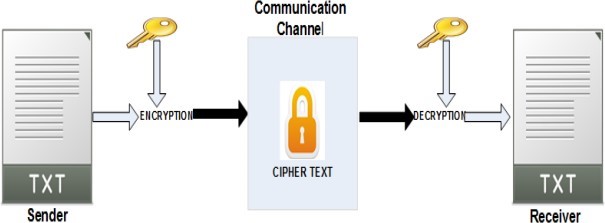
Cryptography algorithms can be intitled two important categories: Symmetric key Cryptography and Asymmetric key cryptography [7]. Figure 2 shows three types of Cryptography.

2. Classification of Cryptography
2.1. Symmetric Key Cryptography
Symmetric algorithm is also called shared key Cryptography. During data transmission, the sender and the receiver share the same key for Encryption and Decryption [5]. The different types of Symmetric algorithms as same as to Data Encryption Standard (DES), Triple Data Encryption Standard (3DES), Advanced Encryption Standard (AES) and Blowfish [8]. Hence, AES is a type of symmetric key cryptography and very powerful and more reliable than the other.
2.2. Asymmetric Key Cryptography
Public key Cryptography is another name for the Asymmetric Algorithm with two keys element that namely ‘Private key’ and ‘Public key’. While the data transmission the users encrypts the clear text with the help of public key known as the cipher text and the receiver Decrypts this cipher text with the help of its private key [8]. The different types of asymmetric algorithms are Rivest Shamir Adlemen (RSA), Diffie Hellman (DH) and Digital Signature Algorithm (DSA), ECC [8].
2.3. Hybrid Cryptography
The concept which combines the both shared key cryptography and public key Cryptographic techniques create new version of algorithms and mentioned as Hybrid Cryptography. A Hybrid Cryptosystem is a protocol using Symmetric and Asymmetric Cryptographic technics together, each to its best advantage. Hybrid Encryption is considered a highly secure type of encryption as long as the public and private keys are fully secure. Hybrid Cryptography is achieved through data transfer using unique session keys along with Symmetrical Encryption. public key Encryption is implemented for random Symmetric key Encryption. The recipient then uses the public key Encryption method to Decrypt the Symmetric key. Once the Symmetric key is recovered, it is then used to Decrypt the message [9]. The blended OR combined in between Symmetric and Asymmetric Cryptographic techniques and create Hybrid Cryptography with three key. However, the three key Hybrid must be more secure than the two key Asymmetric and one key Symmetric. The Table 1 below show the comparison between three different algorithms in respect of key type namely; Symmetric Cryptography, Asymmetric Cryptography and Hybrid Cryptography.
Table1: Shows the comparison between three different algorithms
| Aspect | Symmetric Cryptography | Asymmetric Cryptography | Hybrid Cryptography |
| Key Type | Uses a single shared key |
Uses a key pair (public and private keys) |
Uses both shared and key pairs |
| Key Distribution | Securely sharing a single key can be challenging |
Public keys can be freely distributed, private keys must be kept secret |
Securely share a symmetric key, then use asymmetric encryption for key distribution |
| Speed |
Generally, faster for encryption/decryp tion |
Slower compared to symmetric encryption |
Slower than symmetric but faster than pure asymmetric |
| Security | Vulnerable if the key is compromised |
More secure due to the key pair, but still vulnerable if private key is compromised |
Combines the strengths of both symmetric and asymmetric encryption for improved security |
3. Related Work
In [7], a comparative theory of techniques Encryption in terms of (Symmetric and Asymmetric) keys to algorithms analyzed. In the Symmetric key Encryption (AES) algorithm is found to be better in terms of cost, security and implementation.
Nevertheless, the Asymmetric key Encryption (RSA) algorithm is much better in terms of speed and security. Nevertheless, in paper [7] show and discover that the two algorithms namely AES and RSA are good individually in term of the security and cost but didn’t mention Hybrid techniques OR combined technique simultaneously. The AES with RSE are combined in our proposed system and came out with better results than before Paper [10] by Verma, P. Guha, and S. Mishra that comparative study of different key algorithms namely: AES, DES, 3DES, Blowfish and RSA are analyzed and compared with the results that found among the symmetric encryption algorithm, AES and Blowfish are the most secure and efficient algorithms. The performance and energy consumption of these algorithms are better compared to the others. In case of Asymmetric Encryption algorithm, RSA is secure and can be used for application in wireless network because of its good speed and security. However, in paper [10] show and compare between: AES, DES, 3DES, Blowfish and RSA algorithms individually but didn’t mention Hybrid techniques OR combined technique simultaneously working between mentioned techniques. The AES, DES, 3DES, Blowfish and RSA algorithms are NOT combined and results came out individually.
In paper [11], ECC is explained in detail. Elliptic curve Cryptography (ECC) is a relatively newer form of public key Cryptography that provides more security per bit than other forms of Cryptography still being used today .
In paper [12], Encryption and Decryption of text using ECC is explained with mapping technique. It is concluded that ECC has low power consumption, less memory requirement, small key size and high security.
In paper [13], Hybrid Cryptography technique using AES and ECC is proposed. The system is intended to provide security to a variety of multimedia data ranging from text documents, images, audio, video. Proposed Hybrid system capable of Encrypting and Decrypting the sensitive data to protect it from unauthorized access and attacks.
In paper [14], Hybrid Cryptography approach implemented using AES and ECC. This system provides encryption to the multimedia data such as text, image, audio, video which resulted in an output with 100 percent accuracy without any loss of information.
In paper [15], Different text files are taken as input and encrypted using AES-ECC Hybrid approach. Analysis of AES Encryption with ECC is done on the basis of different parameters like storage requirement, Encryption time, Decryption time.
In paper [16], Hybrid approach for Encryption technique is implemented over a binary image, which provides more accuracy to the encryption process. The ECC and AES are combined in such a way that differentiates them from the usual manner of Encryption. These days with the increasing trend of security it becomes essential to protect the data and information in a better way.
4. Problem Definition
Cryptographic techniques provides the secure data transmission in automated performance analysis of E-services by AES-Based Hybrid Cryptosystems with RSA, ElGamal, and ECC which be a target for our proposed system. The complications existing systems such as a Cryptographic technique with time consume processes. Nevertheless, exactly techniques that isn’t includes the reliability checks on transmitted data and another issue in key changing the presence of security. Thus, the implement an operational Cryptographic algorithm in all phases must be well thought-out to sort a strong method (i.e. AES-Based Hybrid Cryptosystems with RSA, ElGamal, and ECC) with complications in to the proposed method. The proposed Hybrid Cryptographic technique which uses the best features of Symmetric AES-Based Hybrid Cryptosystems with RSA, ElGamal, and ECC. The designed technique helps to reduce the time complexity in Encryption-time, Decryption-time and Throughput-time. This paper solves the performance in time consume also select fewer time response by throughput-time. Finally, our proposed algorithms AES-Based Hybrid Cryptosystems with RSA.
5. Description of Algorithms
Advanced Encryption Standard (AES), Rivest Shamir Adleman (RSA), Elliptic Curve Cryptography (ECC), and ElGamal are indeed powerful cryptographic procedures and use for different purposes and have different features. The AES is a Symmetric-key algorithm widely used for secure facts encryption while RSA operates as an Asymmetric-key algorithm for secure communication and digital signatures. ECC, another asymmetric- key algorithm, relies on elliptic curves for enhanced security with shorter key lengths. ElGamal, also asymmetric are utilized for public-key Encryption and digital signatures based on the discrete logarithm problem. In below explain in detail about all types of Algorithms.
5.1. Advanced Encryption Standard (AES)
The AES algorithm are operating as a Symmetric block cipher system that employs a replace or exchange network. The data block length and key length in AES can be adjusted based on specific requirements, with key lengths available in 128, 192, and 256 bits. The iteration cycle numbers for these round keys are 10, 12, and 14 rounds, respectively. The AES algorithm primarily comprises three components: round change, turns, and key expansion. Each round transformation consists of a non-linear layer, a linear mixture layer, and an add round key layer. The Encryption process of AES is illustrated in Figure 3. Also, there are three different key lengths with round key iteration.
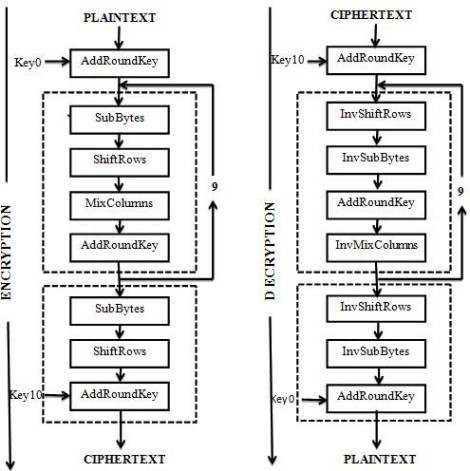
5.2. Elliptic Curve Cryptography (ECC)
In order to compare the public key cryptography that is comparatively more established by an elliptic curve cryptography (ECC) because offers more security per bit than other Cryptographic methods that are still in use nowadays technologies. Nevertheless the Mathematically an elliptic curves are cubic curves that are equivalent to tori topologically. Despite their name which is not closely related to the ellipse. The name of elliptic is integral. By Weierstrass normal equation form. The basic general elliptic curve used for cryptography is of the equation form
which showed in Figure 4. The Curves of this form are defined by different values for 𝑎 and 𝑏 and modifying these values to visualize of the curve and expand, contract, or pinch off to be two separate pieces. Practically the Curves used for Cryptography to defined very large integer values for 𝑎𝑎 and 𝑏𝑏 respectively. The modification of a and b in the mentioned equation is modify the elliptic curve visualization. This mean that is a direct relation between a and b values and elliptic curve.
5.3. RSA Algorithm
The invented of the most widely Asymmetric key cryptosystem known as RSA algorithm is very powerful and user- friendly algorithms that Encryption and authentication Cryptosystem used since that time in many Cryptographic applications for instance an e-mail security, banking, e-commerce and digital signature over web operating systems over the internet facility.
The main security algorithm depends on the difficulty of finding prime numbers factor of large integers. RSA operation consists of three main stages key generation, Encryption and Decryption processes which are explained briefly in following [18].
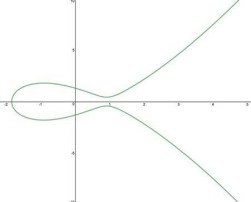
5.3.1. Key Generation
- Select two large prime integer numbers 𝑝 and 𝑞 to calculate the modulus 𝑛 using the formula 𝑛 = 𝑝 × 𝑞.
- Calculate ∅ using the formula ∅(𝑛) = (𝑝 − 1) × (𝑞 − 1).
- Select an integer 𝑒 which is the public exponent, such that GCD (𝑒, ∅(𝑛)) = 1,
- where GCD refers to greatest common divisor function between two numbers.
- Calculate 𝑑 which is the private exponent, such that 𝑒 × 𝑑 = 1 𝑚𝑜𝑑 ∅(𝑛), where 𝑚𝑜𝑑 symbolizes to the modulus operation or the reminder after division.
Hence, (𝑛,𝑒) represents the public Encryption key, while (𝑛, 𝑑) represents the private decryption key [18]. The two prime numbers are the target of the algorithms.
5.3.2. Encryption/Decryption Processes
Let 𝑚 be a message that wanted to be encrypted, then the encrypted message 𝑐 is calculated via the public key (𝑛, 𝑒) using the equation: 𝑐 = 𝑚𝑒 𝑚𝑜𝑑 𝑛. To extract the original message 𝑚, the received encrypted message 𝑐 is decrypted via the private key (𝑛, 𝑑) using the equation: 𝑚 = 𝑐𝑑𝑚𝑜𝑑 𝑛 [18].
5.4. ElGamal algorithm
Security mentioned algorithm depends over hard to calculating discrete logarithms of large prime numbers. If the same plaintext is encrypted using this cryptosystem, then a different cipher text is obtained in each time of Encryption. El- Gamal operation can be described in 3 main steps:
- key generation, 2) Encryption and 3) Decryption processes which are explained briefly as follows.
5.4.1. Key Generation
- First, select a random prime number 𝑝 and two other random numbers 𝑥 and 𝑔, such that both of them are less than 𝑝.
- Calculate 𝑦 using the formula: 𝑦 =𝑔𝑥 𝑚𝑜𝑑 𝑝.
- Thus, (𝑝, 𝑔, 𝑦) represents the public key which can be shared between a group of users, while 𝑥 represents the private key which should be kept secret [19].
5.4.2. Encryption/Decryption Processes
In order to Encrypt a message 𝑚, firstly, a random integer number 𝑘 is selected, such that 𝑘 is relatively prime with
(𝑝 − 1). Secondly, the cipher text pairs (𝑐1, 𝑐2) is calculated using the equations: 𝑐1 = 𝑔𝑘𝑚𝑜𝑑 𝑝 and 𝑐2 = (𝑦𝑘 ×𝑚) 𝑚𝑜𝑑 𝑝. Finally, the cipher text (𝑐1, 𝑐2) is transmitted to the recipient. To Decrypt the cipher text, pair (𝑐1, 𝑐2), the private key 𝑥 is employed to recover the original message 𝑚 using the equation: 𝑚𝑜𝑑 𝑝 [19].
The following pseud codes for ElGamal Algorithms namely Key Generation, Encryption and Decryption. Figure 5: Pseudo-code key generation stage: encryption and decryption.

6. Methodology
Methodology of our proposed system is by Hybrid /blended of two algorithms namely: (i.e. AES with RSA) and (i.e. AES with ECC), also (i.e. AES with ElGamal). The enhancement of security performance for developing and comparing an excellent result in milliseconds unit by Java programing language. Hence, there are an indirect relation between the performance-security and time- consume in milliseconds unit. The Figure 6 show indirect relation between performance-security and time-consume. The creation of web Ecommerce and secured by one of the blended algorithms as a methodology and protect the website. As mentioned, that before the protection of website should be by one of the algorithms.

Nevertheless, the performance analysis is an important part of our proposed system by Hybrid techniques between two algorithms and show that the best performance with less time unit and explained in Table below. The Table 2- show all file types with Hybrid algorithms of AES-RSA performance analysis. The main purpose of our proposed system is mixing two algorithms and test the six types of files such as: jpg, txt, pdf, pptx, mp3, mp4 with different file size over Hybrid AES-RSA. The Encryption time and throughput of all types that show it in Table 2 by blended AES and RSA
Table 2: Hybrid AES-RSA Encryption Performance Comparison: Encryption Time and Throughput
| File Type | Text size (In Kb) | Encryption Time | Encryption Throughput |
| JPG | 9328 | 120 | 71746.15 |
| TXT | 3765 | 55 | 68436.36 |
| 1136 | 25 | 45400.0 | |
| PPTX | 1743 | 31 | 56193.54 |
| MP3 | 57531 | 709 | 81142.45 |
| MP4 | 4555 | 60 | 75900.0 |
| Average Time | 166.66 | 66469.75 | |
The Hybrid techniques between two algorithms and show that the best performance with less time unit and explained in Table below. The Table 3 show all file types with Hybrid algorithms of AES-RSA performance analysis. The main purpose of our proposed system is mixing two algorithms and test the six types of files such as: jpg, txt, pdf, pptx, mp3, mp4 with different file size over Hybrid AES-RSA.
The decryption time and throughput of all types that show it in Table 3 by blended AES and RSA.
Table 3: Hybrid AES-RSA Decryption Performance Comparison: Decryption Time and Throughput
| File Type | Text size (In Kb) | Decryption Time | Decryption Throughput |
| JPG | 9328 | 179 | 52106.14 |
| TXT | 3765 | 75 | 50186.66 |
| 1136 | 50 | 22700.0 | |
| PPTX | 1743 | 47 | 37063.82 |
| MP3 | 57531 | 722 | 79681.44 |
| MP4 | 4555 | 99 | 46000.0 |
| Average Time | 195.33 | 47956.34 | |
The Hybrid techniques between two algorithms and show that the best performance with less time unit and explained in Table below. The Table 4 show all file types with Hybrid algorithms of AES- ECC performance analysis. The main purpose of our proposed system is mixing two algorithms and test the six types of files such as: jpg, txt, pdf, pptx, mp3, mp4 with different file size over Hybrid AES- ECC.
The Encryption time and throughput of all types that show it in Table 4 by blended AES and ECC.
Table 4: Hybrid AES- ECC Encryption Performance Comparison: Encryption Time and Throughput
| File Type | Text size (In Kb) | Encryption Time | Encryption Throughput |
| JPG | 9328 | 735 | 12689.79 |
| TXT | 3765 | 608 | 6190.78 |
| 1136 | 585 | 1940.17 | |
| PPTX | 1743 | 595 | 2927.73 |
| MP3 | 57531 | 1570 | 36643.31 |
| MP4 | 4555 | 648 | 7027.77 |
| Average Time | 790.166 | 11236.59 | |
The Hybrid techniques between two algorithms and show that the best performance with less time unit and explained in Table below. The Table 5 show all file types with Hybrid algorithms of AES- ECC performance analysis. The main purpose of our proposed system is mixing two algorithms and test the six types of files such as: jpg, txt, pdf, pptx, mp3, mp4 with different file size over Hybrid AES- ECC.
The Decryption time and throughput of all types that show it in Table 5 by blended AES and ECC
Table 5: Hybrid AES- ECC Decryption Performance Comparison: Decryption Time and Throughput
|
||||||||||||||||||||||||||||||||||
The Hybrid techniques between two algorithms and show that the best performance with less time unit and explained in Table below. The Table 3 show all file types with Hybrid algorithms of AES- ElGamal performance analysis. The main purpose of our proposed system is mixing two algorithms and test the six types of files such as: jpg, txt, pdf, pptx, mp3, mp4 with different file size over Hybrid AES- ElGamal.
The Encryption time and throughput of all types that show it in Table 6 by blended AES and ElGamal.
Table 6: Hybrid AES- ElGamal Encryption Performance Comparison: Encryption Time and Throughput
| File Type | Text size (In Kb) | Encryption Time | Encryption Throughput |
| JPG | 9328 | 877 | 10635.11 |
| TXT | 3765 | 788 | 4776.64 |
| 1136 | 769 | 1475.942 | |
| PPTX | 1743 | 763 | 2283.09 |
| MP3 | 57531 | 1787 | 32193.62 |
| MP4 | 4555 | 805 | 5657.14 |
| Average Time | 964.83 | 9503.59 | |
The Hybrid techniques between two algorithms and show that the best performance with less time unit and explained in Table below. The Table 7 show all file types with Hybrid algorithms of AES- ElGamal performance analysis. The main purpose of our proposed system is mixing two algorithms and test the six types of files such as: jpg, txt, pdf, pptx, mp3, mp4 with different file size over Hybrid AES- ElGamal.
The Decryption time and throughput of all types that show it in Table 7 by blended AES and ElGamal.
Table 7: Hybrid AES- ElGamal Decryption Performance Comparison: Decryption Time and Throughput
| File Type | Text size (In Kb) | Decryption Time | Decryption Throughput |
| JPG | 9328 | 300 | 31090.0 |
| TXT | 3765 | 150 | 25093.33 |
| 1136 | 115 | 9869.56 | |
| PPTX | 1743 | 127 | 13716.53 |
| MP3 | 57531 | 1170 | 49170.94 |
| MP4 | 4555 | 174 | 26172.41 |
| Average Time | 339.33 | 25852.12 | |
In order to achieve more information from previous comparability between three performance which are: Hybrid algorithm of (AES-RSA, AES-ECC, AES- ElGamal). The Table below shows performance analysis for several Hybrid Encryption algorithm, in respect of the average time and throughput. encryption time and Encryption throughput are two parameters that complete and been blended together. In the context of the presented data information. The three Hybrid /OR blended algorithms are explained below:
- Hybrid AES-RSA: The result blended AES-RSA Encryption algorithms by average time is 166.66 milliseconds. Nevertheless, an encryption time of throughput of blended However, the two pi-chart below give more information AES-RSA is 66469.75 milliseconds. The encryption throughput for this Hybrid approach is much higher and more notable. this combination between two algorithms namely Hybrid AES-RSA, thus the Encryption Time and Encryption Throughput is much less than the other blend algorithms (Hybrid AES-ECC and Hybrid AES- ElGamal). However, the Hybrid AES-RSA is outcome is much better and fewer than the others blended algorithms, which are; Hybrid AES-ECC and Hybrid AES- ElGamal. All result is show in Table 8.
Table 8: Average Time Encryption and Throughput of AES-Based Hybrid Cryptosystems with RSA, ElGamal, and ECC in milliseconds
| Average Time | Encryption Time | Encryption Throughput |
| Hybrid AES- RSA | 166.66 | 66469.75 |
| Hybrid AES- ECC | 790.166 | 11236.59 |
| Hybrid AES- ElGamal | 964.83 | 9503.59 |
In order to achieve more information from previous comparability between three performance which are: Hybrid algorithm of (AES-RSA, AES-ECC, AES- ElGamal). The Table below shows performance analysis for several Hybrid decryption algorithm, in respect of the average time and throughput. decryption time and decryption throughput are two parameters that complete and been blended together. In the context of the presented data information. The three Hybrid /OR blended algorithms are explained below:
- Hybrid AES-RSA: The result blended AES-RSA decryption algorithms by average time is 33 milliseconds. Nevertheless, an Encryption time of throughput of blended AES-RSA is 47956.34 milliseconds. The decryption throughput for this Hybrid approach is much higher and more notable. this combination between two algorithms namely Hybrid AES-RSA, thus the Decryption Time and Decryption Throughput is much less than the other blend algorithms (Hybrid AES-ECC and Hybrid AES- ElGamal). However, the Hybrid AES-RSA is outcome is much better and fewer than the others blended algorithms, which are; Hybrid AES-ECC and Hybrid AES- ElGamal. All result is show in Table 9.
Table 9: Average Time Decryption and Throughput of AES-Based Hybrid Cryptosystems with RSA, ElGamal, and ECC in milliseconds
| Average Time | Decryption Time | Decryption Throughput |
| Hybrid AES- RSA | 195.33 | 47956.34 |
| Hybrid AES- ECC | 223.16 | 40191.54 |
| Hybrid AES- ElGamal | 339.33 | 25852.12 |
However, the two pi-chart below give more information regarding our proposed system average Time Encryption and throughput of AES-Based Hybrid Cryptosystems with RSA, ElGamal, ECC. the Figure 7 show the best performance Hybrid AES-RSA over (Hybrid AES-ECC and Hybrid AES- ElGamal).
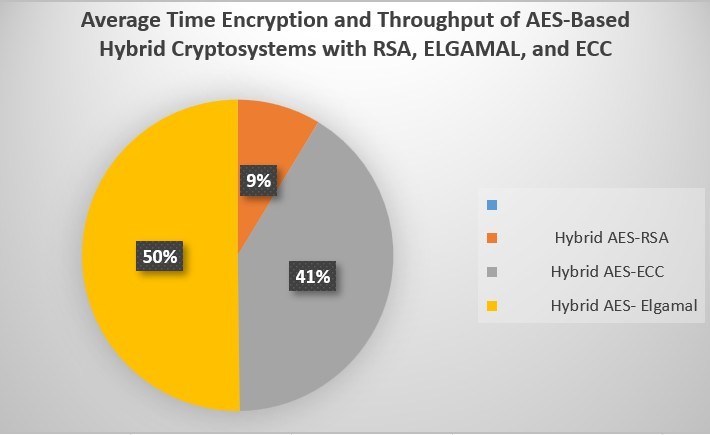
The Hybrid AES-RSA Encryption method demonstrates an average Decryption time of 195.33 milliseconds, achieving a throughput of 47956.34 decrypts per second. In comparison, Hybrid AES-ECC exhibits a slightly longer decryption time of 223.16 milliseconds with a throughput of 40191.54 decrypts per second. Hybrid AES- ElGamal, on the other hand, has a higher Decryption time of 339.33 milliseconds and a throughput of 25852.12 Decrypts per second. which Mentioned and explained clearly in Table 9, by of information in Table 9 created a pie-chart Figure 8.
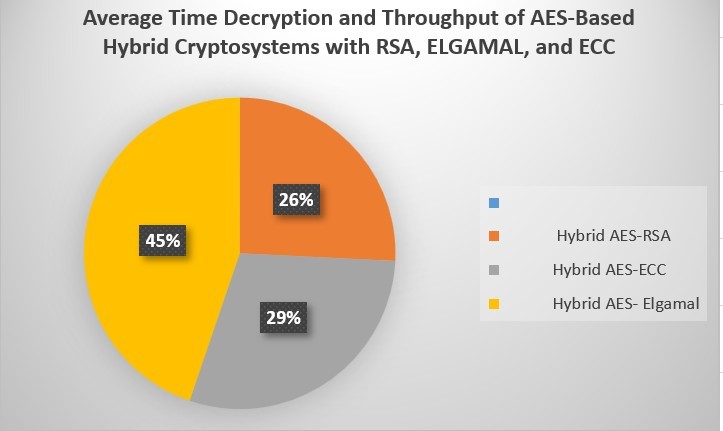
7. Conclusion
In conclusion, the data analysis declared that the performance variations among the three Hybrid encryption methods namely Hybrid AES-RSA, Hybrid AES-ECC, and Hybrid AES- ElGamal. The Hybrid AES-RSA proves superior speed in both schemes’ encryption and decryption processes. This mean that making its an optimal choice for applications requiring swift data protection. Furthermore, it achieved the highest throughput for encryption and decryption and underlining its efficiency. Nevertheless, Hybrid AES-ECC and Hybrid AES-ElGamal exhibit slower encryption and decryption time-consume that is why making them less suitable for time-sensitive tasks. Although both are offer certain cryptographic advantages to reduced throughput may limit their applicability.
Eventually, the selection of an encryption scheme should be based on a careful consideration of security requirements and performance requirements. The speed is important for Hybrid AES-RSA stands out as the most favorable option, while Hybrid AES-ECC and Hybrid AES- ElGamal may be more appropriate in situations where performance is less critical, and specific security features are prioritized.
- P. Patil and R. Bansode, “Performance Evaluation of Hybrid Cryptography Algorithm for Secure Sharing of Text & Images,” International Research Journal of Engineering and Technology, 2020, [Online]. Available: www.irjet.net
- K. H. A. Faraj, A. B. Kanbar, J. Gul-Mohammed, W. M. Hmeed, and S. F. Karim, “Cloud Computing Loading Time Over Different Operating Systems,” Science Journal of University of Zakho, 8(4):154–159, 2020, DOI: https://doi.org/10.25271/sjuoz.2020.8.4.756
- Z. C. Oleiwi, W. A. Alawsi, W. C. Alisawi, A. S. Alfoudi, and L. H. Alfarhani, “Overview and Performance Analysis of Encryption Algorithms,” J. Phys. Conf. Ser., 1664(1), 2020, DOI: https://doi.org/10.1088/1742-6596/1664/1/012051
- P. Chinnasamy, S. Padmavathi, R. Swathy, and S. Rakesh, “Efficient Data Security Using Hybrid Cryptography on Cloud Computing,” Lect. Notes Networks Syst., 145(September):537–547, 2021, DOI: https://doi.org/10.1007/978-981-15-7345-3_46
- F. Maqsood, M. Ahmed, M. M. Ali, and M. A. Shah, “Cryptography: A Comparative Analysis for Modern Techniques,” Int. J. Adv. Comput. Sci. Appl., 8(6):442-448, 2017, DOI: https://doi.org/10.14569/IJACSA.2017.080659
- P. Verma, J. Shekhar, P. Preety, and A. Asthana, “A Survey for Performance Analysis Various Cryptography Techniques Digital Contents,” International Journal of Computer Science and Mobile Computing, 4(1):522–531, 2015
- N. Bisht and S. Singh, “A Comparative Study of Some Symmetric and Asymmetric Key Cryptography Algorithms,” International Journal of Innovative Research in Science, Engineering and Technology, 4(3):1028-1031, 2015, DOI: https://doi.org/10.15680/IJIRSET.2015.0403043
- S. Chandra and S. Paira, “A Comparative Survey of Symmetric and Asymmetric Key Cryptography,” in 2014 International Conference on Electronics, Communication and Computational Engineering (ICECCE), 2014, pp. 1-4, DOI: https://doi.org/10.1109/ICECCE.2014.7086640
- P. Kuppuswamy and S. Q. Y. Al-Khalidi, “Hybrid Encryption/Decryption Technique Using New Public Key and Symmetric Key Algorithm,” Manage. Inf. Syst. Rev., 19(2):1-13, 2014, DOI: https://doi.org/10.6131/MISR.2014.1902.01
- P. Verma, P. Guha, and S. Mishra, “Comparative Study of Different Cryptographic Algorithms,” Int. J. Emerg. Trends Technol. Comput. Sci., 5(2):58-63, 2016
- R. Harkanson and Y. Kim, “Applications of Elliptic Curve Cryptography: A Light Introduction to Elliptic Curves and a Survey of Their Applications,” in 12th Annual Cyber and Information Security Research Conference, USA, 2017, pp. 1-7
- K. Keerthi and B. Surendiran, “Elliptic Curve Cryptography for Secured Text Encryption,” in International Conference on Circuits Power and Computing Technologies, India, 2017
- S. C. Iyer, R. R. Sedamkar, and S. Gupta, “A Novel Idea on Multimedia Encryption Using Hybrid Crypto Approach,” in 7th International Conference on Communication, Computing and Virtualization, 2016, 79:293-298
- S. C. Iyer, R. R. Sedamkar, and S. Gupta, “An Efficient Multimedia Encryption Using Hybrid Crypto Approaches,” Int. J. Recent Trends Eng. Res., 2:442-452, 2016
- S. Sharma and V. Chopra, “Analysis of AES Encryption with ECC,” in Proceedings of International Interdisciplinary Conference On Engineering Science & Management, 2016, pp. 195
- D. Ameta and S. Upadhyay, “A Hybrid Approach for Image Encryption Using Different Number Iterations in ECC and AES Techniques,” Int. J. Comput. Appl., 175(3), 2017, DOI: https://doi.org/10.5120/ijca2017915469
- N. Mathura and R. Bansode, “AES Based Text Encryption Using 12 Rounds with Dynamic Key Selection,” in Proc. 7th Int. Conf. Commun., Comput., Virtualization, 2016, pp. 131-135, DOI: https://doi.org/10.1016/j.procs.2016.03.131
- F. Yousif, “Encryption and Decryption of Audio Signal Based on RSA Algorithm,” Int. J. Eng. Technol. Manage. Res., 5(7):259-264, 2018, DOI: https://doi.org/10.29121/ijetmr.v5.i7.2018.259
- O. A. Imran, S. F. Yousif, I. S. Hameed, W. N. Al-Din Abed, and A. T. Hammid, “Implementation of El-Gamal Algorithm for Speech Signals Encryption and Decryption,” Procedia Comput. Sci., 167:1028–1037, 2020, DOI: https://doi.org/10.1016/j.procs.2020.03.402
Citations by Dimensions
Citations by PlumX
Crossref Citations
- Vinayachandra, Krishna Prasad K, "Blockchain Based Cryptographic Algorithm for Data Protection in Electronic Voting System." EAI Endorsed Transactions on Internet of Things, vol. 11, no. , pp. , 2025.
- Rebwar Khalid Muhammed, Zryan Najat Rashid , Shaida Jumaah Saydah , "A Hybrid Approach to Cloud Data Security Using ChaCha20 and ECDH for Secure Encryption and Key Exchange." Kurdistan Journal of Applied Research, vol. 10, no. 1, pp. 66, 2025.
No. of Downloads Per Month

